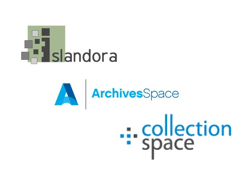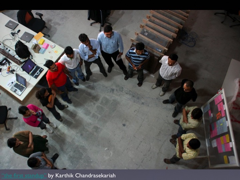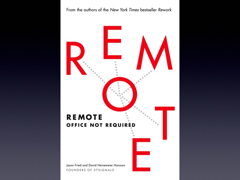Setting the Right Environment: Remote Staff, Service Provider Participants, and Big-Tent Open Source Communities
 I was asked recently to prepare a 15 minute presentation on lessons learned working with a remote team hosting open source applications. The text of that presentation is below with links added to more information. Photographs are from DPLA and Flickr, and are used under Public Domain or Creative Commons derivatives-okay licenses. Photographs link to their sources.
I was asked recently to prepare a 15 minute presentation on lessons learned working with a remote team hosting open source applications. The text of that presentation is below with links added to more information. Photographs are from DPLA and Flickr, and are used under Public Domain or Creative Commons derivatives-okay licenses. Photographs link to their sources.
Thank you for the opportunity to talk with you today. This is a description of a long-running project at LYRASIS to host open source software on behalf of our members and others in the cultural heritage community. The genesis of this project is member research done at the formation of LYRASIS from SOLINET, PALINET and NELINET. Our membership told us that they wanted the advantages of open source software but did not have the resources within their organization to host it themselves. Our goals were -- and still are -- to create sustainable technical infrastructure for open source hosting, to provide top-notch support for clients adopting that hosted open source, and to be a conduit through which clients engage in the open source community.
 In the past couple of years, this work has focused on three software packages: the Islandora digital asset system, the ArchivesSpace system for archival finding aids, and most recently the CollectionSpace system for museum objects. Each of these, in sequence, involved new learning and new skills. First was Islandora. For those who are not familiar with Islandora, it is a digital asset system built atop Drupal and Fedora Commons repository system. It is a powerful stack with a lot of moving parts, and that makes it difficult for organizations to set up. One needs experience in PHP and Drupal, Java servlet engines, SOLR, and Fedora Commons among other components. In our internal team those skills were distributed among several staff members, and we are spread out all over the country: I'm in central Ohio, there is a developer in California, a data specialist in Baltimore, a sysadmin in Buffalo, two support and training staff in Atlanta, and servers in the cloud all over North America.
In the past couple of years, this work has focused on three software packages: the Islandora digital asset system, the ArchivesSpace system for archival finding aids, and most recently the CollectionSpace system for museum objects. Each of these, in sequence, involved new learning and new skills. First was Islandora. For those who are not familiar with Islandora, it is a digital asset system built atop Drupal and Fedora Commons repository system. It is a powerful stack with a lot of moving parts, and that makes it difficult for organizations to set up. One needs experience in PHP and Drupal, Java servlet engines, SOLR, and Fedora Commons among other components. In our internal team those skills were distributed among several staff members, and we are spread out all over the country: I'm in central Ohio, there is a developer in California, a data specialist in Baltimore, a sysadmin in Buffalo, two support and training staff in Atlanta, and servers in the cloud all over North America.
Importance of Internal Communication
 That first goal I mentioned earlier -- creating a sustainable technical architecture -- took a lot of work and experimentation for us. All of us had worked in library IT in earlier jobs. Except for our sysadmin, though, none of us had built a hosted service to scale. It was a fast-moving time, with lots of small successes and failures, swapping of infrastructure components, and on-the-fly procedures. It was hard to keep up. We took a page from the Scrum practice and instituted a daily standup meeting. The meeting started at 10:30am eastern time, which got our west coast person up just a little early, and -- since we were spread out all over the country -- used a group Skype video conference.
That first goal I mentioned earlier -- creating a sustainable technical architecture -- took a lot of work and experimentation for us. All of us had worked in library IT in earlier jobs. Except for our sysadmin, though, none of us had built a hosted service to scale. It was a fast-moving time, with lots of small successes and failures, swapping of infrastructure components, and on-the-fly procedures. It was hard to keep up. We took a page from the Scrum practice and instituted a daily standup meeting. The meeting started at 10:30am eastern time, which got our west coast person up just a little early, and -- since we were spread out all over the country -- used a group Skype video conference.
 The morning standups usually took longer than the typical 15 minutes. In addition to everyone's reports, we shared information about activities with the broader LYRASIS organization as well as informal things about our personal lives -- what our kids were doing, our vacation plans, or laughing about the latest internet meme. It was the sort of sharing that would happen naturally when meeting someone at the building entrance or popping a head over a cubicle wall, and that helped cement our social bonds. We kept the Skype window open throughout the day and used the text chat function to post status updates, ask questions of each other, and share links to funny cat pictures. Our use of this internal communication channel has evolved over the years. We no longer have the synchronous video call every morning for our standup; we post our morning reports as chat messages. If we were to hire a new team member, I would make a suggestion to the team that we restart the video calls at least for a brief period to acclimate the new person to the group. We've also moved from Skype to Slack -- a better tool for capturing, organizing, searching, and integrating our activity chatter. What started out as a suggestion by one of our team members to switch to Slack for the seven of us has grown organically to include about a third of the LYRASIS staff.
The morning standups usually took longer than the typical 15 minutes. In addition to everyone's reports, we shared information about activities with the broader LYRASIS organization as well as informal things about our personal lives -- what our kids were doing, our vacation plans, or laughing about the latest internet meme. It was the sort of sharing that would happen naturally when meeting someone at the building entrance or popping a head over a cubicle wall, and that helped cement our social bonds. We kept the Skype window open throughout the day and used the text chat function to post status updates, ask questions of each other, and share links to funny cat pictures. Our use of this internal communication channel has evolved over the years. We no longer have the synchronous video call every morning for our standup; we post our morning reports as chat messages. If we were to hire a new team member, I would make a suggestion to the team that we restart the video calls at least for a brief period to acclimate the new person to the group. We've also moved from Skype to Slack -- a better tool for capturing, organizing, searching, and integrating our activity chatter. What started out as a suggestion by one of our team members to switch to Slack for the seven of us has grown organically to include about a third of the LYRASIS staff.
 In their book "Remote: Office Not Required" the founders of 37Signals describe the "virtual water cooler". They say that the idea is to have a single, permanent chat room where everyone hangs out all day to shoot the breeze, post funny pictures, and generally goof around. They acknowledge that it can also be used to answer questions about work, but its primary function is to provide social cohesion. With a distributed team, initiating communication with someone is an intentional act. It doesn't happen serendipitously by meeting at a physical water cooler. The solution is to lower the barrier of initiating that communication while still respecting the boundaries people need to get work done.
In their book "Remote: Office Not Required" the founders of 37Signals describe the "virtual water cooler". They say that the idea is to have a single, permanent chat room where everyone hangs out all day to shoot the breeze, post funny pictures, and generally goof around. They acknowledge that it can also be used to answer questions about work, but its primary function is to provide social cohesion. With a distributed team, initiating communication with someone is an intentional act. It doesn't happen serendipitously by meeting at a physical water cooler. The solution is to lower the barrier of initiating that communication while still respecting the boundaries people need to get work done.
How does your core team communicates among itself. How aware are they of what each other are doing? Do they know each other's strengths and feel comfortable enough to call on each other for help? Do the members share a sense of forward accomplishment with the project as a whole?
Clear Demarcation of Responsibilities between Hosting Company and Organizational Home
 One of the unique thing about the open source hosting activity at LYRASIS is that for two of the projects we are also closely paired with organizational homes. Both ArchivesSpace and CollectionSpace have separate staff within LYRASIS that report to their own community boards and have their own financial structure. LYRASIS provides human resource and fiscal administrative services to the organizational homes, and we share resources and expertise among the groups. From the perspective of a client to our services, though, it can seem like the hosting group and the organizational home are one entity. We run into confusion about why we in the hosting group cannot add new features or address bugs in the software. We gently remind our clients that the open source software is bigger than our hosting of it -- that there is an organizational home that is advancing the software for all users and not just our hosted clients.
One of the unique thing about the open source hosting activity at LYRASIS is that for two of the projects we are also closely paired with organizational homes. Both ArchivesSpace and CollectionSpace have separate staff within LYRASIS that report to their own community boards and have their own financial structure. LYRASIS provides human resource and fiscal administrative services to the organizational homes, and we share resources and expertise among the groups. From the perspective of a client to our services, though, it can seem like the hosting group and the organizational home are one entity. We run into confusion about why we in the hosting group cannot add new features or address bugs in the software. We gently remind our clients that the open source software is bigger than our hosting of it -- that there is an organizational home that is advancing the software for all users and not just our hosted clients.
 Roles between open source organizations and hosting companies should be clearly defined as well, and the open source organization must help hosting providers make this distinction clear to the provider's clients as well as self-hosting institutions. For instance, registered service provider agreements could include details for how questions about software functionality are handed off between the hosting provider and the organizational home. I would also include a statement from the registered service provider about the default expectations for when code and documentation will be contributed back to the community's effort. This would be done in such a way as to give a service provider an avenue to distinguish itself from others while also strengthening the core community values of the project. While there is significant overlap, there are members of ArchivesSpace that are not hosted by LYRASIS and there are clients hosted by LYRASIS that are not members of ArchivesSpace.
Roles between open source organizations and hosting companies should be clearly defined as well, and the open source organization must help hosting providers make this distinction clear to the provider's clients as well as self-hosting institutions. For instance, registered service provider agreements could include details for how questions about software functionality are handed off between the hosting provider and the organizational home. I would also include a statement from the registered service provider about the default expectations for when code and documentation will be contributed back to the community's effort. This would be done in such a way as to give a service provider an avenue to distinguish itself from others while also strengthening the core community values of the project. While there is significant overlap, there are members of ArchivesSpace that are not hosted by LYRASIS and there are clients hosted by LYRASIS that are not members of ArchivesSpace.
How does your project divide responsibilities between the community and the commercial affiliates? What are the expectations that hosted adopters should have about the roles of support, functionality enhancement, and project governance?
Empowering the Community
 Lastly, one of the clear benefits of developing software as open source is the shared goals of the community participants. Whether someone is a project developer, a self-hosted user of the software, a service provider, or a client hosted by a service provider, everyone wants to see the software thrive and grow. While the LYRASIS hosting service does provide a way for clients to use the functionality of open source software, what we are really aiming to offer is a path for clients to get engaged in the project's community by removing the technology barriers to hosting. We are selling a service, but sometimes I think the service that we are selling is not necessarily the one that the client is initially looking for. What clients come to us seeking is a way to make use of the functions that they see in the open source software. What we want them to know is how adopting open source software is different. As early as the first inquiry about hosting, we let clients know that the organizational home exists and offer to make an introduction to the project's community organizer. When a project announces important information, we reflect that information on to our client mailing list. When a client files an issue in the LYRASIS hosting ticket system for an enhancement request, we forward that request to the project but we also urge the client to send the description of their use case through the community channels.
Lastly, one of the clear benefits of developing software as open source is the shared goals of the community participants. Whether someone is a project developer, a self-hosted user of the software, a service provider, or a client hosted by a service provider, everyone wants to see the software thrive and grow. While the LYRASIS hosting service does provide a way for clients to use the functionality of open source software, what we are really aiming to offer is a path for clients to get engaged in the project's community by removing the technology barriers to hosting. We are selling a service, but sometimes I think the service that we are selling is not necessarily the one that the client is initially looking for. What clients come to us seeking is a way to make use of the functions that they see in the open source software. What we want them to know is how adopting open source software is different. As early as the first inquiry about hosting, we let clients know that the organizational home exists and offer to make an introduction to the project's community organizer. When a project announces important information, we reflect that information on to our client mailing list. When a client files an issue in the LYRASIS hosting ticket system for an enhancement request, we forward that request to the project but we also urge the client to send the description of their use case through the community channels.
 Maintaining good client support while also gently directing the client into the community's established channels is a tough balancing act. Some clients get it right away, and become active participants in the community. Others are unable or unwilling to take that leap to participation in the project's greater community. As a hosting provider we've learned to be flexible and supportive where ever the client is on its journey in adopting open source. Open source communities need to be looking for ways a hosted client's staff -- no matter what the level of technical expertise -- can participate in the work of the community.
Maintaining good client support while also gently directing the client into the community's established channels is a tough balancing act. Some clients get it right away, and become active participants in the community. Others are unable or unwilling to take that leap to participation in the project's greater community. As a hosting provider we've learned to be flexible and supportive where ever the client is on its journey in adopting open source. Open source communities need to be looking for ways a hosted client's staff -- no matter what the level of technical expertise -- can participate in the work of the community.
Do you have low barriers of entry for comments, corrections, and enhancements to the documentation? Is there a pipeline in place for triaging issue reports and comments that both help the initiator and funnel good information into the project's teams? And is that triaging work valued on par with code contributions? Can you develop a mentoring program that aids new adopters into the project's mainstream activities?
Conclusion
 As you can probably tell, I'm a big believer in the open source method of developing the systems and services that our patrons and staff need. I have worked on the adopter side of open source -- using DSpace and Fedora Commons and other library-oriented software...to say nothing of more mainstream open source projects. I have worked on the service provider side of open source -- making Islandora, ArchivesSpace and CollectionSpace available to organizations that cannot host the software themselves and empowering them to join the community. Through this experience I've learned a great deal about how many software projects think, what adopters look for in projects, what other service providers need to be successful community participants. Balancing the needs of the project, the needs of self-hosted adopters, and the needs of service providers is delicate -- but the results are worth it.
As you can probably tell, I'm a big believer in the open source method of developing the systems and services that our patrons and staff need. I have worked on the adopter side of open source -- using DSpace and Fedora Commons and other library-oriented software...to say nothing of more mainstream open source projects. I have worked on the service provider side of open source -- making Islandora, ArchivesSpace and CollectionSpace available to organizations that cannot host the software themselves and empowering them to join the community. Through this experience I've learned a great deal about how many software projects think, what adopters look for in projects, what other service providers need to be successful community participants. Balancing the needs of the project, the needs of self-hosted adopters, and the needs of service providers is delicate -- but the results are worth it.
I also believe that by using new technologies and strategies, distributed professionals can build a hosting service that is attractive to clients. We may not be able to stand around a water cooler or conference table, but we can replicate the essence of those environments with tools, policies, and a collaborative attitude. In doing so we have more freedom to hire the staff the make the right fit for our organization, no matter where they are located.